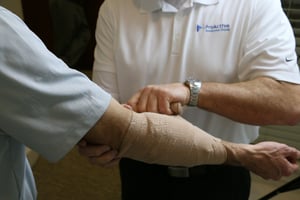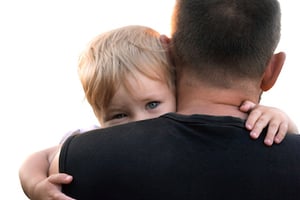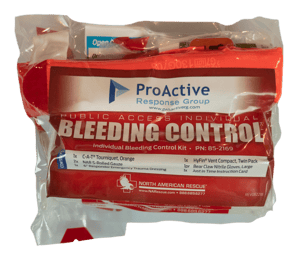Adding video cameras, a new access control system, and the 15-minute active shooter training video will surely be the best approach to building a comprehensive security program. We had an all-hands meeting complete with doughnuts and coffee!! All bases have been covered. Implementing this initiative will keep us clear of any liability issues in the event of an active attack taking place. Everyone will know what to do. Right????
Our Blog: Equipping & Empowering
Peeling Back the Onion: A Multi-Layered Approach to Security
Topics: Corporations, Schools, Industrial Facilities, General Prevention & Response Tips
There are two types of people in a crisis — those who act and those who do not.
At ProActive Response Group, we talk a lot about having survivor's mindset. It's an important part of our training because in order to survive a violent encounter, you must first have the will to survive.
In today's blog article we want to dive a little deeper into this idea of a survivor's mentality by uncovering the five characteristics that are true of a survivor.
How to Address the Aftermath of a Workplace Violence Incident
It's amazing how quickly a story of a workplace violence incident will go in and out of the news. From the perspective of an outside party reading the news or tuning in, active shooter events seem to be forgotten almost as quickly as they happen.
The thing is, there's a lot of aftermath a company deals with that the news doesn't cover. In order for a business, corporation or other organization to recover from a traumatic workplace violence incident, there must be an intentional plan or procedure for dealing with the aftermath.
Let's look at the steps companies should be taking in order to properly handle the aftermath of an active shooter event.
The Difference Between First Aid and Emergency Casualty Care
Most people have taken some form of first aid class at some point in their lives. Additionally, many people take first aid courses regularly because their jobs require it, or simply because they want to keep their certification up to date.
First aid training is an important skill to have. It prepares you to take action in a variety of situations. If someone is choking on a piece of food, First Aid training prepares you to do the Heimlich maneuver. Or, if a person has a heart attack and stops breathing, you would utilize your First Aid training by doing CPR.
However, there are a different set of emergency circumstances that could require different training.
Topics: General Prevention & Response Tips, Emergency Medical Response
Beyond the Bleed: How to Spot and Treat Injuries When There's No Bleeding
Stopping the bleed is essential to saving lives during an active shooter event or any other type of emergency. But bleeding isn't the only sign of a serious injury, and it certainly is not the only type of injury you could encounter after an act of violence.
In order to treat injuries, you must also know how to identify them. In this article, we'll address three types of traumatic injuries that don't require bleeding control, but that do require the attention of a first responder like yourself.
Best Practices of Tourniquet Application: Clearing Up the Confusion
Tourniquets like the CAT (Combat Application Tourniquet) have been around for decades, but the conception of tourniquet application was invented long before that.
It's no surprise, then, that over such an extensive timeline, rules about applying tourniquets have changed in ways big and small. Each tweak of the process and adjustment to protocol has been the result of dedicated research and testing, and we can therefore confidently adhere to the changes knowing that we are providing the best emergency medical response that we are capable of providing in that moment.
Any time information changes, confusion can form and misinformation can spread. Many times, people fail to realize anything has changed at all. To squelch some of the confusion, we're addressing some commonly overlooked or unknown best practices for tourniquet application.
Should Children's Medical Injuries Be Treated Differently Than Adults?
It’s one thing to put a tourniquet on a 195-pound adult – it’s quite another to put a tourniquet on a child.
Or is it?
Many people are terrified by the thought of treating a child or an infant suffering from severe bleeding or another life-threatening injury, but for anyone who ever finds themselves in that situation, a few moments of hesitation could reduce a child’s chances of survival.
Topics: Schools, Places of Worship, General Prevention & Response Tips
5 Items You NEED in Your Emergency Medical Kit and Why
First aid kits have their place — like maybe when you get a paper cut or tear a hangnail — but the bandaids and antiseptic wipes in your basic first aid kit will not stop severe bleeding or help you treat any other kind of life-threatening injury.
It's time to increase your preparedness. Instead of preparing for basic first aid, train for emergency medical response, especially bleed control. After all, if you're ready to effectively handle the big things, then responding to the little things like minor incisions are second nature. Everybody wins when you're prepared to respond to severe hemorrhage but only have to clean up a scraped knee on the playground.
Better to have it and not need it, than to need it and not have it, they say. That couldn't be more true in the context of medical kits. Let's look at 5 specific items you should always have in your emergency medical kit.
Levels of Situational Awareness: Which zone are you in?
Situational awareness is important for everyone — every teacher, student, working professional, church attendee, and stay-at-home parent. Granted, it's unrealistic, and arguably unnecessary, for civilians to maintain the same level of acute awareness as people whose livelihoods are based around it. Imagine how exhausting it would be to remain on high alert 24/7, not to mention how much it would exhaust the people around us as well!
U.S. Marine Jeff Cooper developed the Color Code concept to identify different levels of situational awareness and to help people understand how to act as someone who is situationally aware.
Practical and straightforward, the Color Code is still taught to law enforcement officers today. Let's take a look at it from a civilian perspective...
Don't Make These Mistakes in an Active Shooter Situation
Rarely is there just one right way to respond in an emergency. Everyone reacts a little differently during a crisis, but through our years of experience in law enforcement and EMS, we've seen some of the same poor reactions repeated in various traumatic events.
It's amazing the things our brains will tell us (or fail to tell us) to do when we're under stress. It's no wonder that people freeze up when they should fight, or that they run away when they're the only ones who can provide lifesaving medical care.
You can never truly be prepared for an active shooter event, but you can increase your likelihood of having an empowered response. Start by being aware of 5 of the most common mistakes people make under stress.
.png?width=499&height=133&name=Logo-menu%20(1).png)











